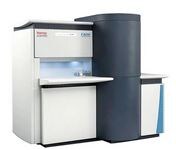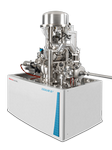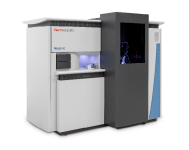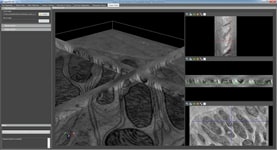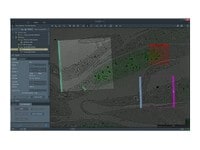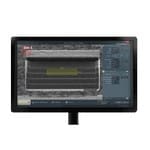Search

Materials Science
Materials Science
Advanced materials characterization with electron microscopy and spectroscopy.
Join the conversation
Advances in materials science
Innovative materials play essential roles in safety, clean energy, transportation, human health, and industrial productivity. To fuel continued innovation, researchers want to deepen their understanding of the physical and chemical properties of materials (morphological, structural, magnetic, thermal, and mechanical) from the macro- to nanoscale. Whether discovering new materials, solving analytical problems, improving processes, or assuring product quality, electron microscopy is capable of providing insight at all scales and modalities. The discoveries resulting from materials science research help enhance researchers’ ability to successfully correlate structural properties with functional performance. In turn, this insight helps commercial enterprises innovate products and processes to gain important time-to-market and cost advantages.
Materials characterization
Analytical solutions, including electron microscopy and spectroscopy, from Thermo Fisher Scientific can help you address your most pressing challenges, including;
- Developing new functional materials that meet the demands of today’s unique social and economic challenges
- Supporting the discovery of new materials with reproducible data from complementary techniques
- Solving materials and method development challenges to improve processes and investigate product defects
- Publishing groundbreaking discoveries, writing winning grant proposals, or patenting novel materials
- Assuring defects are rejected before they reach customers
- Taking your ideas to market quickly and keeping your company competitive
Defect analysis of a lithium ion battery cathode. Serial sectioning and imaging with Plasma FIB DualBeam followed by digital 3D reconstruction using Avizo software provides a highly detailed model of the sample.

Scanning Electron Microscopy for Materials Science
Scanning electron microscopy (SEM) is a powerful imaging technique that uses focused beams of electrons to produce high-resolution, three-dimensional images of sample surfaces at the nanoscale. This method is essential for researchers seeking detailed topographical, compositional, and morphological insights into a wide range of materials.
Industrial manufacturing product selector
The product selector is here to assist you in choosing the most suitable Scanning Electron Microscope (SEM) system and software for your research. Find out in a few minutes which SEM best suits your research application:
Materials Science learning center
Access a targeted collection of application notes, case studies, videos, webinars, and white papers covering a range of applications.

TEM Sample Preparation
Proper sample preparation is a critical step in the scientific experiment process—a step that can determine the ultimate quality and accuracy of the results. FIB-SEM instruments can be used to facilitate fully automated in situ TEM sample preparation, enabling new chemistries and technologies while advancing research in batteries, polymers, metals, and more.
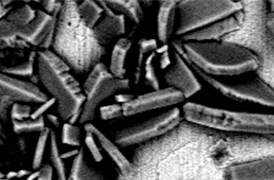
Controle de processo
A indústria moderna exige alta produtividade com qualidade superior, um equilíbrio mantido por meio de um controle de processo robusto. As ferramentas SEM e TEM com software de automação dedicado proporcionam informações rápidas e em várias escalas para monitoramento e aprimoramento de processos.
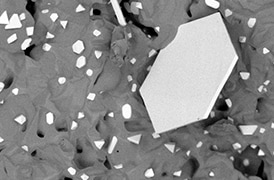
Controle de qualidade
O controle de qualidade e a garantia de qualidade são essenciais na indústria moderna. Oferecemos uma gama de ferramentas de microscopia eletrônica e espectroscopia para análises multidimensionais e multimodais de defeitos, permitindo que você tome decisões confiáveis e informadas para controle e melhoria de processos.
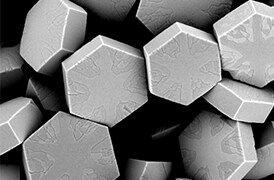
Pesquisa de materiais fundamentais
Novos materiais são investigados em escalas cada vez menores para o máximo controle de suas propriedades físicas e químicas. A microscopia eletrônica fornece aos pesquisadores percepções importantes sobre uma ampla variedade de características materiais em escala micro a nano.
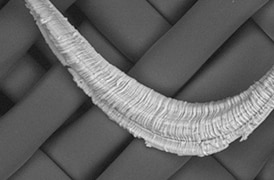
Limpeza
Mais do que nunca, a fabricação moderna necessita de componentes confiáveis e de qualidade. Com a microscopia eletrônica de varredura (SEM), a análise de limpeza de peças pode ser feita internamente, fornecendo uma ampla variedade de dados analíticos e encurtando o ciclo de produção.

Preparação de amostra (S)TEM
Os microscópios DualBeam permitem a preparação de amostras ultrafinas e de alta qualidade para análise de (S)TEM. Graças à automação avançada, os usuários com qualquer nível de experiência podem obter resultados de nível especializado para uma ampla gama de materiais.

Caracterização de materiais 3D
O desenvolvimento de materiais muitas vezes requer caracterização 3D em várias escalas. Os instrumentos DualBeam permitem a secção em série de grandes volumes e a subsequente geração de imagens SEM nanométricas, que podem ser processadas em reconstruções 3D de alta qualidade da amostra.

Prototipagem nanométrica
À medida que a tecnologia segue miniaturizando, a demanda por dispositivos e estruturas nanométricos aumenta cada vez mais. A nanoprototipagem 3D com instrumentos DualBeam ajuda a projetar, criar e inspecionar rapidamente protótipos funcionais micrométricos e nanométricos.
_Technique_800x375_144DPI.jpg)
Tomografia EDS 3D
A pesquisa de materiais modernos depende cada vez mais da análise nanométrica em três dimensões. A caracterização 3D, incluindo dados de composição para contexto químico e estrutural completos, é possível com a EM 3D e a espectroscopia de raios X por energia dispersiva.
_Technique_800x375_144DPI.jpg)
Análise elementar EDS
A EDS proporciona informações de composição vitais para observações em microscópio eletrônico. Principalmente, nossos exclusivos sistemas detectores Super-X e Dual-X adicionam opções para maior produtividade e/ou sensibilidade, permitindo otimizar a aquisição de dados para atender às prioridades de pesquisa.

Mapeamento elementar em escala atômica com EDS
A EDS de resolução atômica fornece um contexto químico sem igual para análise de materiais, diferenciando a identidade elementar de átomos individuais. Quando combinado com a TEM de alta resolução, é possível observar a organização precisa dos átomos em uma amostra.
_Technique_800x375_144DPI.jpg)
Geração de imagens usando HRSTEM e HRTEM
A microscopia eletrônica de transmissão tem um valor inestimável para a caracterização da estrutura de nanopartículas e nanomateriais. A STEM e TEM de alta resolução permitem dados de resolução atômica juntamente com informações sobre composição química.
_Technique_800x375_144DPI.jpg)
Formação de imagens com contraste de fase diferencial
A pesquisa eletrônica moderna depende da análise nanométrica das propriedades elétricas e magnéticas. A STEM (DPC-STEM) de contraste de fase diferencial é capaz de gerar imagens da força e da distribuição de campos magnéticos em uma amostra e exibir a estrutura do domínio magnético.

Geração de imagens de amostras quentes
O estudo de materiais em condições reais muitas vezes envolve trabalhar em altas temperaturas. O comportamento dos materiais à medida que eles se recristalizam, derretem, deformam ou reagem na presença de calor pode ser estudado in situ com microscopia eletrônica de varredura ou ferramentas DualBeam.

Espectroscopia fotoeletrônica de raios X
A espectroscopia fotoeletrônica de raios X (XPS) permite analisar a superfície, fornecendo a composição elementar, bem como o estado químico e eletrônico dos 10 nm superiores de um material. Com a criação de perfil de profundidade, a análise XPS se estende a informações de composição de camadas.
_Technique_800x375_144DPI.jpg)
SEM ambiental (ESEM)
A SEM ambiental permite a geração de imagens dos materiais em seu estado nativo. Isso é perfeitamente adequado para pesquisadores acadêmicos e industriais que precisam testar e analisar amostras molhadas, sujas, reativas, gasosas ou não compatíveis com vácuo.

Espectroscopia de perda eletrônica de energia
A pesquisa da ciência de materiais se beneficia da EELS de alta resolução para uma ampla variedade de aplicações analíticas. Isso inclui mapeamento elementar de alto rendimento, alta taxa de sinal e ruído e sondagem de estados de oxidação e fótons de superfície.

Preparação de amostra APT
A tomografia por sonda atômica (APT) fornece análise de composição de resolução atômica 3D de materiais. A microscopia de feixe de íons focalizados (FIB) é uma técnica essencial para a preparação de amostra de alta qualidade, orientada e específica de local para a caracterização APT.

Corte transversal
O corte transversal fornece dados adicionais ao revelar informações de subsuperfície. Os instrumentos DualBeam apresentam excelentes colunas de feixe de íons focalizados para corte transversal de alta qualidade. A automação permite realizar o processamento autônomo de amostras com alta produtividade.

Experimentação in situ
A observação direta e em tempo real de alterações microestruturais com a microscopia eletrônica é necessária para entender os princípios subjacentes de processos dinâmicos, como recristalização, crescimento de grãos e transformação de fases durante o aquecimento, o resfriamento e a umidificação.

Análise de partículas
A análise de partículas tem uma função vital na pesquisa de nanomateriais e no controle de qualidade. A resolução nanométrica e a formação de imagens excelentes da microscopia eletrônica podem ser combinadas com software especializado proporcionando uma rápida caracterização de pós e partículas.

Catodoluminescência
A catodoluminescência (CL) descreve a emissão de luz de um material quando ele é excitado por um feixe de elétrons. Este sinal, captado por um detector CL especializado, carrega informações sobre a composição da amostra, defeitos de cristal ou propriedades fotônicas.

Análise em várias escalas
Os materiais novos precisam ser analisados em resolução cada vez maior, mantendo o contexto maior da amostra. A análise em várias escalas permite correlacionar várias ferramentas e modalidades de geração de imagens, como a microTC de raios X, DualBeam, laser PFIB, SEM e TEM.

SIMS
O detector TOF-SIMS (espectrometria de massa iônica secundária de tempo de voo) para as ferramentas de microscopia eletrônica de varredura de feixe de íons focalizados (FIB-SEM) permite a caracterização analítica de alta resolução de todos os elementos na tabela periódica, mesmo em baixas concentrações.

ColorSEM
Usando a EDS (espectroscopia de raios X por energia dispersiva) com quantificação ao vivo, a tecnologia ColorSEM transforma as imagens SEM em uma técnica colorida. Agora, qualquer usuário pode adquirir dados elementares continuamente para obter informações mais completas do que nunca.

Fluxo de trabalho de partículas automatizado
O fluxo de trabalho de nanopartículas automatizado (APW) consiste em um fluxo de trabalho de microscópio eletrônico de transmissão para análise de nanopartículas, oferecendo imagens de grande área e alta resolução e aquisição de dados nanométricos em um processamento dinâmico.

Preparação de amostra (S)TEM
Os microscópios DualBeam permitem a preparação de amostras ultrafinas e de alta qualidade para análise de (S)TEM. Graças à automação avançada, os usuários com qualquer nível de experiência podem obter resultados de nível especializado para uma ampla gama de materiais.

Caracterização de materiais 3D
O desenvolvimento de materiais muitas vezes requer caracterização 3D em várias escalas. Os instrumentos DualBeam permitem a secção em série de grandes volumes e a subsequente geração de imagens SEM nanométricas, que podem ser processadas em reconstruções 3D de alta qualidade da amostra.

Prototipagem nanométrica
À medida que a tecnologia segue miniaturizando, a demanda por dispositivos e estruturas nanométricos aumenta cada vez mais. A nanoprototipagem 3D com instrumentos DualBeam ajuda a projetar, criar e inspecionar rapidamente protótipos funcionais micrométricos e nanométricos.
_Technique_800x375_144DPI.jpg)
Tomografia EDS 3D
A pesquisa de materiais modernos depende cada vez mais da análise nanométrica em três dimensões. A caracterização 3D, incluindo dados de composição para contexto químico e estrutural completos, é possível com a EM 3D e a espectroscopia de raios X por energia dispersiva.
_Technique_800x375_144DPI.jpg)
Análise elementar EDS
A EDS proporciona informações de composição vitais para observações em microscópio eletrônico. Principalmente, nossos exclusivos sistemas detectores Super-X e Dual-X adicionam opções para maior produtividade e/ou sensibilidade, permitindo otimizar a aquisição de dados para atender às prioridades de pesquisa.

Mapeamento elementar em escala atômica com EDS
A EDS de resolução atômica fornece um contexto químico sem igual para análise de materiais, diferenciando a identidade elementar de átomos individuais. Quando combinado com a TEM de alta resolução, é possível observar a organização precisa dos átomos em uma amostra.
_Technique_800x375_144DPI.jpg)
Geração de imagens usando HRSTEM e HRTEM
A microscopia eletrônica de transmissão tem um valor inestimável para a caracterização da estrutura de nanopartículas e nanomateriais. A STEM e TEM de alta resolução permitem dados de resolução atômica juntamente com informações sobre composição química.
_Technique_800x375_144DPI.jpg)
Formação de imagens com contraste de fase diferencial
A pesquisa eletrônica moderna depende da análise nanométrica das propriedades elétricas e magnéticas. A STEM (DPC-STEM) de contraste de fase diferencial é capaz de gerar imagens da força e da distribuição de campos magnéticos em uma amostra e exibir a estrutura do domínio magnético.

Geração de imagens de amostras quentes
O estudo de materiais em condições reais muitas vezes envolve trabalhar em altas temperaturas. O comportamento dos materiais à medida que eles se recristalizam, derretem, deformam ou reagem na presença de calor pode ser estudado in situ com microscopia eletrônica de varredura ou ferramentas DualBeam.

Espectroscopia fotoeletrônica de raios X
A espectroscopia fotoeletrônica de raios X (XPS) permite analisar a superfície, fornecendo a composição elementar, bem como o estado químico e eletrônico dos 10 nm superiores de um material. Com a criação de perfil de profundidade, a análise XPS se estende a informações de composição de camadas.
_Technique_800x375_144DPI.jpg)
SEM ambiental (ESEM)
A SEM ambiental permite a geração de imagens dos materiais em seu estado nativo. Isso é perfeitamente adequado para pesquisadores acadêmicos e industriais que precisam testar e analisar amostras molhadas, sujas, reativas, gasosas ou não compatíveis com vácuo.

Espectroscopia de perda eletrônica de energia
A pesquisa da ciência de materiais se beneficia da EELS de alta resolução para uma ampla variedade de aplicações analíticas. Isso inclui mapeamento elementar de alto rendimento, alta taxa de sinal e ruído e sondagem de estados de oxidação e fótons de superfície.

Preparação de amostra APT
A tomografia por sonda atômica (APT) fornece análise de composição de resolução atômica 3D de materiais. A microscopia de feixe de íons focalizados (FIB) é uma técnica essencial para a preparação de amostra de alta qualidade, orientada e específica de local para a caracterização APT.

Corte transversal
O corte transversal fornece dados adicionais ao revelar informações de subsuperfície. Os instrumentos DualBeam apresentam excelentes colunas de feixe de íons focalizados para corte transversal de alta qualidade. A automação permite realizar o processamento autônomo de amostras com alta produtividade.

Experimentação in situ
A observação direta e em tempo real de alterações microestruturais com a microscopia eletrônica é necessária para entender os princípios subjacentes de processos dinâmicos, como recristalização, crescimento de grãos e transformação de fases durante o aquecimento, o resfriamento e a umidificação.

Análise de partículas
A análise de partículas tem uma função vital na pesquisa de nanomateriais e no controle de qualidade. A resolução nanométrica e a formação de imagens excelentes da microscopia eletrônica podem ser combinadas com software especializado proporcionando uma rápida caracterização de pós e partículas.

Catodoluminescência
A catodoluminescência (CL) descreve a emissão de luz de um material quando ele é excitado por um feixe de elétrons. Este sinal, captado por um detector CL especializado, carrega informações sobre a composição da amostra, defeitos de cristal ou propriedades fotônicas.

Análise em várias escalas
Os materiais novos precisam ser analisados em resolução cada vez maior, mantendo o contexto maior da amostra. A análise em várias escalas permite correlacionar várias ferramentas e modalidades de geração de imagens, como a microTC de raios X, DualBeam, laser PFIB, SEM e TEM.

SIMS
O detector TOF-SIMS (espectrometria de massa iônica secundária de tempo de voo) para as ferramentas de microscopia eletrônica de varredura de feixe de íons focalizados (FIB-SEM) permite a caracterização analítica de alta resolução de todos os elementos na tabela periódica, mesmo em baixas concentrações.

ColorSEM
Usando a EDS (espectroscopia de raios X por energia dispersiva) com quantificação ao vivo, a tecnologia ColorSEM transforma as imagens SEM em uma técnica colorida. Agora, qualquer usuário pode adquirir dados elementares continuamente para obter informações mais completas do que nunca.

Fluxo de trabalho de partículas automatizado
O fluxo de trabalho de nanopartículas automatizado (APW) consiste em um fluxo de trabalho de microscópio eletrônico de transmissão para análise de nanopartículas, oferecendo imagens de grande área e alta resolução e aquisição de dados nanométricos em um processamento dinâmico.

Pesquisa de baterias
O desenvolvimento de baterias tornou-se possível pela análise em várias escalas com microTC, SEM e TEM, espectroscopia Raman, XPS e visualização e análise 3D digital. Saiba como essa abordagem fornece as informações estruturais e químicas necessárias para construir baterias melhores.

Pesquisa de metais
A produção efetiva de metais requer um controle preciso de inclusões e precipitações. Nossas ferramentas automatizadas podem executar uma série de tarefas críticas para a análise de metais, incluindo: contagem de nanopartículas, análise química de EDS e preparação de amostras de TEM.

Pesquisa de polímeros
A microestrutura de polímero determina as características e o desempenho do material em massa. A microscopia eletrônica permite uma análise abrangente micrométrica da morfologia e da composição do polímero para aplicações de Pesquisa e Desenvolvimento e de controle de qualidade.

Pesquisa geológica
A geociência depende da observação consistente e precisa em várias escalas de recursos em amostras de rochas. A SEM-EDS, combinada com software de automação, permite a análise direta e em larga escala da textura e da composição mineral para a pesquisa da petrologia e da mineralogia.

Petróleo e gás
À medida que a demanda por petróleo e gás continua, há uma necessidade contínua de extração eficiente e eficaz de hidrocarbonetos. A Thermo Fisher Scientific oferece uma variedade de soluções de microscopia e espectroscopia para diferentes aplicações de ciência do petróleo.

Nanopartículas
Os materiais têm propriedades fundamentalmente diferentes nanometricamente e macrometricamente. Para estudá-las, a instrumentação S/TEM pode ser combinada com a espectroscopia de raios X por energia dispersiva para obter dados de resolução nanométrica ou até mesmo subnanométrica.

Forênsica
Os microtraços de evidências de cena de crime podem ser analisados e comparados usando a microscopia eletrônica como parte de uma investigação forense. As amostras compatíveis incluem fragmentos de vidro e de tinta, marcas de ferramentas, drogas, explosivos e resíduo de disparo de arma de fogo.

Pesquisa de catálise
Os catalisadores são essenciais para a maioria dos processos industriais modernos. Sua eficiência depende da composição e da morfologia microscópicas das partículas catalíticas. A EM com EDS é a técnica ideal para estudar essas propriedades.

Fibras e filtros
O diâmetro, a morfologia e a densidade das fibras sintéticas são parâmetros fundamentais que determinam a vida útil e a funcionalidade de um filtro. A microscopia eletrônica de varredura (SEM) é a técnica ideal para investigar essas características de forma rápida e fácil.

Materiais 2D
A pesquisa de materiais inovadores está cada vez mais interessada na estrutura de materiais de baixa dimensão. A microscopia eletrônica de transmissão de varredura com correção de sonda e monocromação permite a formação de imagens de alta resolução de materiais bidimensionais.

Teste de materiais automotivos
Cada componente em um veículo moderno é projetado para segurança, eficiência e desempenho. A caracterização detalhada dos materiais automotivos pela microscopia eletrônica e pela espectroscopia informa as decisões críticas do processo, as melhorias do produto e os novos materiais.
Serviços de microscopia eletrônica para
a ciência dos materiais
Para garantir o desempenho ideal do sistema, fornecemos acesso a uma rede de especialistas em serviços de campo, suporte técnico e peças de reposição certificadas.






















